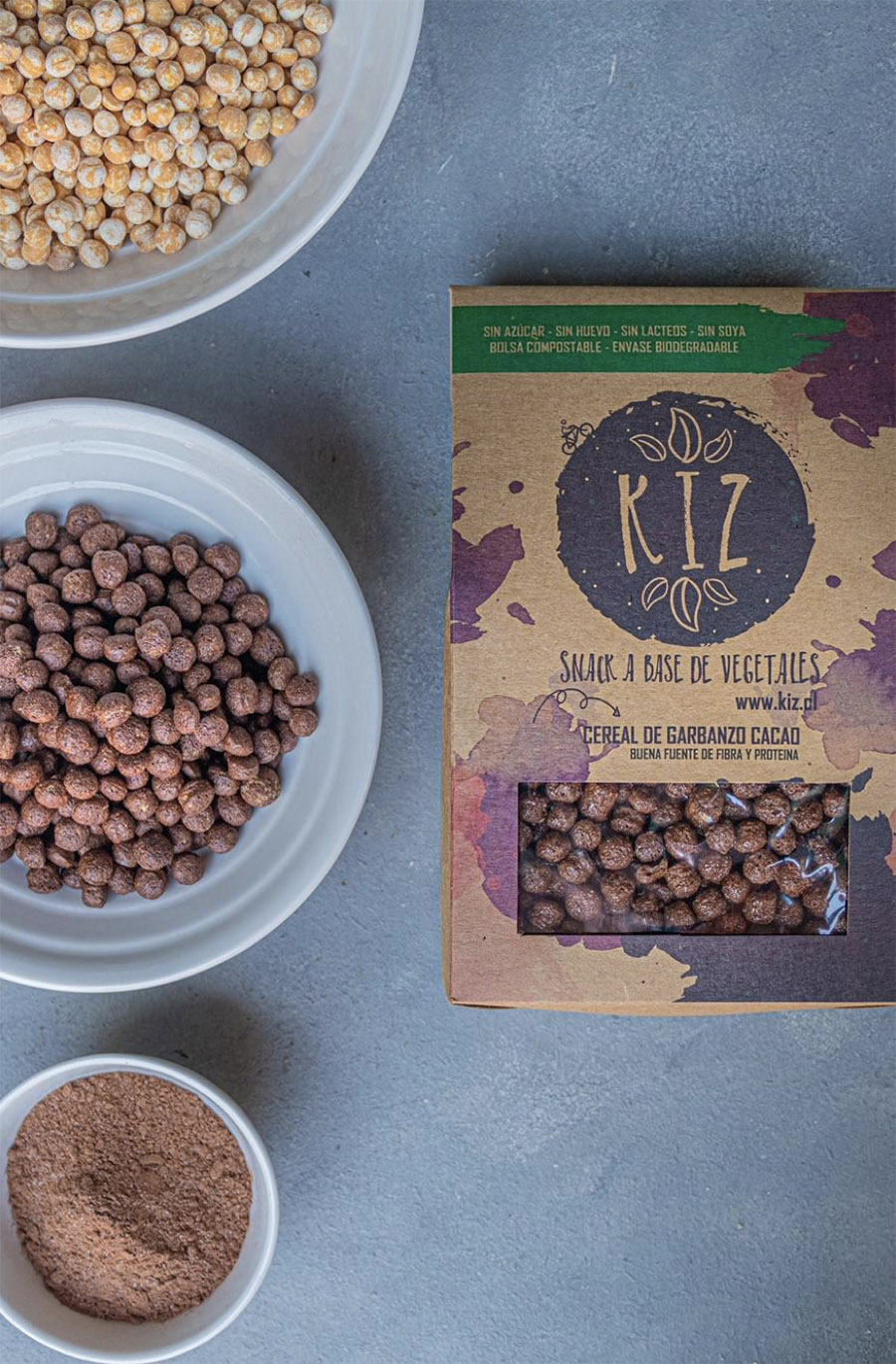March 2, 2022
Francisca spoke to Luke Wilkinson about building a brand from the ground up and why chickpeas were the perfect choice for a nutritious, delicious cereal.


In light of the health food boom of the last few years, the demand for more health-conscious snacks has soared, and Chile is no exception to the trend. Francisca Vera Vilches is the owner of Kiz, a company whose focus is on providing for the needs of a growing number of people in search of healthy gluten-, lactose-, and nut-free foods.
The idea came to me around the time my daughter was around two years old. She had a couple of playmates around the same age who had serious allergies to nuts, soy and lactose, so I started doing a bit of research into different ingredients like pulse flours and different types of cereals. From there, I started to make my first products, which were biscuits made from chickpea flour, quinoa flour and rice flour. They were a huge hit! So I decided to transform this into something bigger and that's when I had the idea for breakfast cereals.
Why pulses? Well, all the snacks that were free from nuts and wheat around the time we started were good, but pretty limited in terms of nutrition, so the idea of Kiz was to create products that were low in calories but also extremely nourishing. We chose to use pulses so as not to have to add protein and fiber via more artificial means, and they took the form of a breakfast cereal because it’s easy to eat.
We realized that by combining the pulse flours with cacao, we had a cereal that people loved and was three times better for you nutritionally than regular. We do sweeten them a little, some with dates and some with Stevia, as, whilst the product can of course be eaten by adults, it was made with children in mind. ‘Kiz’ is actually the Turkish word for ‘girl’.
In small local markets. I was basically a sales woman going from tiny market to tiny market selling my biscuits but, over time, they built up a reputation and things went from strength to strength. That first year, my team and I worked our socks off! It was a lot of work explaining our products to the customers and running the business side of things at the same time. It’s not easy when you’re entering a market in which there is very little awareness of the importance of the ingredients you're offering and it falls to you to make sure customers have all the information they need. In the end, awareness grew by word of mouth, via the vegans, yogis and the people with allergy needs who already took a lot of care with the food they ate.
We started out towards the end of 2018 and at that point the vegan boom hadn't really kicked off here in Chile so, in some ways, we were pioneers in introducing certain ingredients like chickpeas. I always remember people walking by our stand in the market and, when they saw chickpeas and cacao on the sign, they would stop and say, “What is that!?” - they thought we were crazy!
Over time, we realized that health foods had gone from being niche to something much bigger and more global. This meant that we could scale up our production. Both internationally and here in Chile, there are huge rates of obesity, particularly among children, so there is plenty of demand for healthy snacks. I think these poor eating habits have something to do with parents passing down behaviors that their parents passed on to them. But my generation of thirty-somethings seem to want to shake things up. We can see that health foods are quite well integrated into the diets of the younger generations and the boom of the industry in general has allowed us to grow alongside it.
We work with chickpeas, quinoa and apples. We take great pride in working with Chilean quinoa particularly, because it isn't easy to produce here as it isn't naturally occuring like it is in Peru and other countries in South America. We work with farmers in Temuco and some others to the south, and it is really high quality but I doubt the quantities of quinoa they produce here would ever extend to large international exports, unfortunately. Working with apples has been amazing too - they're easy to dehydrate and then pulverize to make a flour that’s high in fiber and low in carbs.
There’s actually a new pulse-based product of ours which will be on the market soon: crunchy sticks made of lentil flour, flavored with sea salt like the rest of our line. In the past we’ve had to choose between lentils and chickpeas as a raw material but, whilst chickpeas are more difficult to work with, they’re also more beneficial in terms of nutrition and their levels of protein. Chickpeas have always been grown here in Chile, and they’re easy to grind up and work with after the extrusion process. Once we have our chickpea flour, we mix it together with the other ingredients and place them into a mold for shaping.
Yes, we did tests to compare them: lentils have higher protein levels per hundred grams and less fat than chickpeas. Chickpeas, on the other hand, have higher levels of fiber and carbohydrates and more vitamins such as vitamin B9 and vitamin E, which aren’t found in lentils. In terms of minerals, chickpeas have high levels of calcium, phosphorus, magnesium, sodium, iron and zinc.
Technically, it's more or less a draw, but once you mix them with the other ingredients to create our product we simply get better numbers using chickpeas.

The chickpea production zones we use for our products are in the regions of O'higgins and Maule. In the region of O’higgins, there is no use of pesticides whatsoever; in Maule the levels of pesticide use are under 1% so cross-contamination risk is low.
To convince people, we just spent time explaining that we had a very healthy, nutritious food that they would love. When they realized it was made of chickpeas there was sometimes a bit of a reaction: “Oh, well I can't have chickpeas because they make me feel bloated.” Then we would explain that we were using chickpea flour, which doesn’t make you gassy in the same way as the whole grain. My mother and I and the rest of the team put a lot of time into educating customers and we generated a lot of sales off the back of it.
Health foods are still quite a small market here. Not even all of the big brands are able to get their products into the supermarkets, let alone the smaller brands like ours. For example, our products can be found in 55 shops around the country, but these are all small shops specializing in health foods and it's not so easy to step up from that into larger retail.
That said, we are about to get Kiz into a supermarket here called Unimarc and in July we are hoping to be on the shelves of Walmart, as well. We've also been selected by Orgullo Chileno (Chilean Pride), which is a ProChile project that promotes exports. In order to get the stamp of Orgullo Chileno, all of our raw materials must come from Chile, so we found Chilean farmers to supply the chickpeas for our flour and other ingredients. The production, the packaging; all of it happens right here. Through these schemes, we’re hoping to start exporting to the American and Mexican markets - they’re huge potential for us there, as exporting to Europe is much more difficult due to the regulations.
I think there is still a long way to go. Chile is a country that exports a lot of grains, the majority of which are for soups and stews and things like that. I think it's possible that some of the other types of products that are exported under the organic label aren't necessarily completely organic whereas, if you have a niche product like ours, they make absolutely sure that it is because that’s your main selling point. This means that the farmers that supply have to be 100% organic, which is tricky for any farmer to commit to because, if you run your farm organically, you often find there is a shortfall in the harvest. In the end, although we are a country of agriculture, we’re still not not a country whose focus is organic agriculture. We are moving in that direction, but only slowly.
First and foremost, we really want to position ourselves more in mainstream retail, and we’d like to succeed in exporting to US and Mexico markets. With regards to the cereals themselves, what we’ll continue to try to do is see where there are needs in the market and start thinking about how we can set about covering them, from an agricultural level right up to the final product.

Francisca Vera Vilches / Snacks / Chile / Kiz / gluten / lactose / nut-free / nuts / soy / lactose / flours / cereals / biscuits / cacao / organic
Disclaimer: The opinions or views expressed in this publication are those of the authors or quoted persons. They do not purport to reflect the opinions or views of the Global Pulse Confederation or its members.